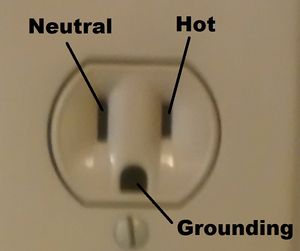Neutral line: Difference between revisions
J.williams (talk | contribs) m 1 revision imported |
No edit summary |
||
| Line 1: | Line 1: | ||
[[Category:Done | [[Category:Done 2018-07-20]] | ||
[[File:Three-pronged outlet.jpg|thumbnail|right|Figure 1. A labelled three-pronged outlet.<ref>This picture contributed by someone on the team.</ref>]] | [[File:Three-pronged outlet.jpg|thumbnail|right|Figure 1. A labelled three-pronged outlet.<ref>This picture contributed by someone on the team.</ref>]] | ||
<onlyinclude>The '''neutral line''' refers to the part of the [[distribution system]] that returns the power that left the transmission lines through a [[hot line]] or phase line to do [[work]] on an [[electrical load]]. Neutral lines are at zero potential relative to the [[ground]], meaning that ideally, they do not pose a [[shock hazard]] (but good safety practice is always a good idea).</onlyinclude><ref> J. Andrews, ''A+ Guide to Hardware: Managing, Maintaining and Troubleshooting'', 5th ed. Cengage Learning, 2009, pp.48-49</ref> This is because neutral lines are wires connected deep in the ground. That means that the neutral side of the [[outlet]] would carry most of the electric energy directly into the ground and very little current would go through a person touching the device. The neutral lines used in distribution systems terminate at a distinct slot in [[electrical outlet]]s (see figure 1).<ref>D. Lowe. ''Alternating Current in Electronics: Hot, Neutral, and Ground Wires'' [Online]. Available:http://www.dummies.com/how-to/content/alternating-current-in-electronics-hot-neutral-and.html</ref> | <onlyinclude>The '''neutral line''' refers to the part of the [[distribution system]] that returns the power that left the transmission lines through a [[hot line]] or phase line to do [[work]] on an [[electrical load]]. Neutral lines are at zero potential relative to the [[ground]], meaning that ideally, they do not pose a [[shock hazard]] (but good safety practice is always a good idea).</onlyinclude><ref> J. Andrews, ''A+ Guide to Hardware: Managing, Maintaining and Troubleshooting'', 5th ed. Cengage Learning, 2009, pp.48-49</ref> This is because neutral lines are wires connected deep in the ground. That means that the neutral side of the [[outlet]] would carry most of the electric energy directly into the ground and very little current would go through a person touching the device. The neutral lines used in distribution systems terminate at a distinct slot in [[electrical outlet]]s (see figure 1).<ref>D. Lowe. ''Alternating Current in Electronics: Hot, Neutral, and Ground Wires'' [Online]. Available:http://www.dummies.com/how-to/content/alternating-current-in-electronics-hot-neutral-and.html</ref> | ||
For a more in depth discussion, including circuit diagrams please see [http://www.allaboutcircuits.com/vol_1/chpt_3/8.html All about circuits]. | For a more in depth discussion, including circuit diagrams please see [http://www.allaboutcircuits.com/vol_1/chpt_3/8.html All about circuits]. | ||
==For Further Reading== | |||
*[[Electrical outlet]] | |||
*[[Distribution system]] | |||
*[[Electrical load]] | |||
*[[Ground]] | |||
*Or explore a [[Special:Random|random page]] | |||
==References== | ==References== | ||
{{Reflist}} | {{Reflist}} | ||
[[Category:Uploaded]] | [[Category:Uploaded]] | ||
Revision as of 19:36, 17 July 2018

The neutral line refers to the part of the distribution system that returns the power that left the transmission lines through a hot line or phase line to do work on an electrical load. Neutral lines are at zero potential relative to the ground, meaning that ideally, they do not pose a shock hazard (but good safety practice is always a good idea).[2] This is because neutral lines are wires connected deep in the ground. That means that the neutral side of the outlet would carry most of the electric energy directly into the ground and very little current would go through a person touching the device. The neutral lines used in distribution systems terminate at a distinct slot in electrical outlets (see figure 1).[3]
For a more in depth discussion, including circuit diagrams please see All about circuits.
For Further Reading
- Electrical outlet
- Distribution system
- Electrical load
- Ground
- Or explore a random page
References
- ↑ This picture contributed by someone on the team.
- ↑ J. Andrews, A+ Guide to Hardware: Managing, Maintaining and Troubleshooting, 5th ed. Cengage Learning, 2009, pp.48-49
- ↑ D. Lowe. Alternating Current in Electronics: Hot, Neutral, and Ground Wires [Online]. Available:http://www.dummies.com/how-to/content/alternating-current-in-electronics-hot-neutral-and.html

